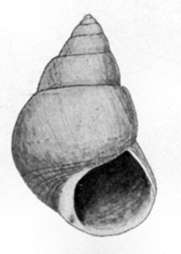Phasianotrochus hirasei
Phasianotrochus hirasei is a species of sea snail, a marine gastropod mollusk in the family Trochidae, the top snails.[1]
| Phasianotrochus hirasei | |
|---|---|
 | |
| Apertural view of a shell of Phasianotrochus hirasei | |
| Scientific classification | |
| Kingdom: | Animalia |
| Phylum: | Mollusca |
| Class: | Gastropoda |
| Clade: | Vetigastropoda |
| Order: | Trochida |
| Superfamily: | Trochoidea |
| Family: | Trochidae |
| Genus: | Phasianotrochus |
| Species: | P. hirasei |
| Binomial name | |
| Phasianotrochus hirasei (Pilsbry, H.A., 1901) | |
| Synonyms | |
| |
WoRMS mentions this species as a taxon inquirendum Cantharidus hirasei Pilsbry, 1901 [2]
Description
The height of the shell attains 15 mm. The ovate-pyramidal shell is solid. The color of the shell is a uniform olive or a brownish-olive, belted with numerous reddish spiral bands. The shell is smooth except for faint growth lines above. The base of the shell scores by 5 or 6 narrow, spaced, concentric grooves that become stronger near the axis. The conic spire contains 6½ convex whorls. The body whorl is subangular at the periphery and convex beneath. The oblique aperture is brilliantly green inside, with a dusky submarginal band and a pale edge. The white columella is opaque and rounded. The umbilical region is imperforate or has a very minute perforation.[1]
This is the only species of Phasianotrochus outside Australia.
Distribution
This marine species occurs off Japan and Korea.
References
- Tryon (1889), Manual of Conchology XI, Academy of Natural Sciences, Philadelphia
- Sartori, André F. (2015). Cantharidus hirasei Pilsbry, 1901. In: MolluscaBase (2015). Accessed through: World Register of Marine Species at http://www.marinespecies.org/aphia.php?p=taxdetails&id=754155 on 2016-09-08
- Pilsbry, H.A. 1901. New Mollusca from Japan, the Loo Choo Islands, Formosa and the Philippines. Proceedings of the Academy of Natural Sciences of Philadelphia 53: 193-210.page(s): 199
External links
- "Phasianotrochus hirasei". Gastropods.com. Retrieved 16 January 2019.
| Wikimedia Commons has media related to Phasianotrochus hirasei. |